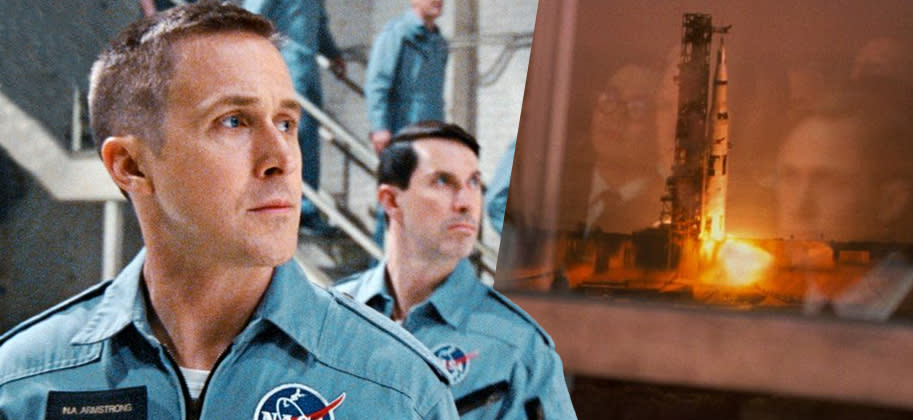‘First Man’ Director Damien Chazelle & Neil Armstrong’s Family On Flag Flap: It’s Not A Political Statement

Damien Chazelle’s Neil Armstrong biopic First Man received good marks this week when it landed for its world premiere as the opening-night film at the Venice Film Festival. But not all saw it that way, with a small backlash brewing over the lack of a scene showing Armstrong’s planting of the American flag on the moon’s surface during his legendary 1969 moon landing.
The flag appears several times during the movie, which stars Ryan Gosling as Armstrong, but not having the iconic flag-plant has riled many online who believe the omission may have been deliberate. Sen. Marco Rubio was among those who noted it:
This is total lunacy. And a disservice at a time when our people need reminders of what we can achieve when we work together. The American people paid for that mission,on rockets built by Americans,with American technology & carrying American astronauts. It wasn’t a UN mission. https://t.co/eGwBq7hj8C
— Marco Rubio (@marcorubio) August 31, 2018
Chazelle, the film’s Oscar-winning director, has responded to critics, saying he chose to reflect parts of Armstrong’s life other’s didn’t know about, and that it was not a political statement. “I wanted the primary focus in that scene to be on Neil’s solitary moments on the moon — his point of view as he first exited the LEM, his time spent at Little West Crater, the memories that may have crossed his mind during his lunar EVA,” he said (read the full statement below).
Armstrong’s sons Rick and Mark, and First Man author James R. Hansen, in a separate statement, also backed the movie’s choices, saying it’s “a film that focuses on things you didn’t see or may not remember about Neil’s journey to the moon.” (See their statement below after Chazelle’s).
In Venice, First Man‘s world premiere screening on the Lido on Wednesday received a three-minute standing ovation. Deadline’s Andreas Wiseman reported wasn’t a rapturous reception, but it was respectful, which perhaps was fitting for such a skilled, clear-sighted and, at times, solemn film, whose reserve matches that of its lead character.
The film, co-starring Claire Foy, continues on its fall-festival run before hitting theaters October 12 via Universal.
Here is Chazelle’s statement:
In “First Man” I show the American flag standing on the lunar surface, but the flag being physically planted into the surface is one of several moments of the Apollo 11 lunar EVA that I chose not to focus upon. To address the question of whether this was a political statement, the answer is no. My goal with this movie was to share with audiences the unseen, unknown aspects of America’s mission to the moon — particularly Neil Armstrong’s personal saga and what he may have been thinking and feeling during those famous few hours.
I wanted the primary focus in that scene to be on Neil’s solitary moments on the moon — his point of view as he first exited the LEM, his time spent at Little West Crater, the memories that may have crossed his mind during his lunar EVA. This was a feat beyond imagination; it was truly a giant leap for mankind. This film is about one of the most extraordinary accomplishments not only in American history, but in human history. My hope is that by digging under the surface and humanizing the icon, we can better understand just how difficult, audacious and heroic this moment really was.
Here is the Armstrong-Hanson statement:
We’ve read a number of comments about the film today and specifically about the absence of the flag planting scene, made largely by people who haven’t seen the movie. As we’ve seen it multiple times, we thought maybe we should weigh in.
This is a film that focuses on what you don’t know about Neil Armstrong. It’s a film that focuses on things you didn’t see or may not remember about Neil’s journey to the moon. The filmmakers spent years doing extensive research to get at the man behind the myth, to get at the story behind the story. It’s a movie that gives you unique insight into the Armstrong family and fallen American Heroes like Elliot See and Ed White. It’s a very personal movie about our dad’s journey, seen through his eyes.
This story is human and it is universal. Of course, it celebrates an America achievement. It also celebrates an achievement “for all mankind,” as it says on the plaque Neil and Buzz left on the moon. It is a story about an ordinary man who makes profound sacrifices and suffers through intense loss in order to achieve the impossible.
Although Neil didn’t see himself that way, he was an American hero. He was also an engineer and a pilot, a father and a friend, a man who suffered privately through great tragedies with incredible grace. This is why, though there are numerous shots of the American flag on the moon, the filmmakers chose to focus on Neil looking back at the earth, his walk to Little West Crater, his unique, personal experience of completing this journey, a journey that has seen so many incredible highs and devastating lows.
In short, we do not feel this movie is anti-American in the slightest. Quite the opposite. But don’t take our word for it. We’d encourage everyone to go see this remarkable film and see for themselves.
Related stories
Venice Day Four Mood: Festival & Netflix Riding High
Hamptons Film Festival Sets 'First Man' & 'Roma' Screenings, Taps Alan Alda For Career Award
'First Man' Blasts Off Awards Season In Venice, Gets Three-Minute Ovation
Get more from Deadline.com: Follow us on Twitter, Facebook, Newsletter

